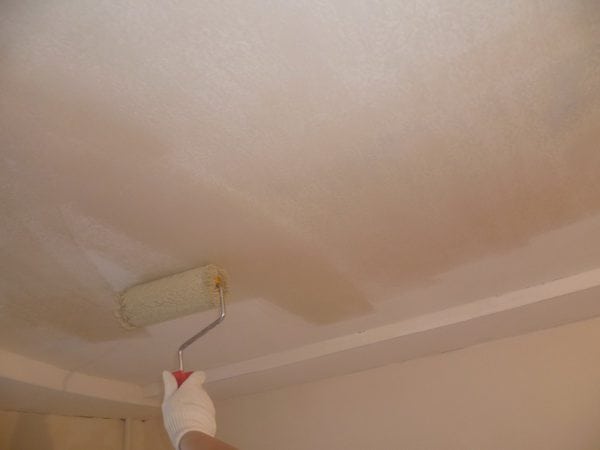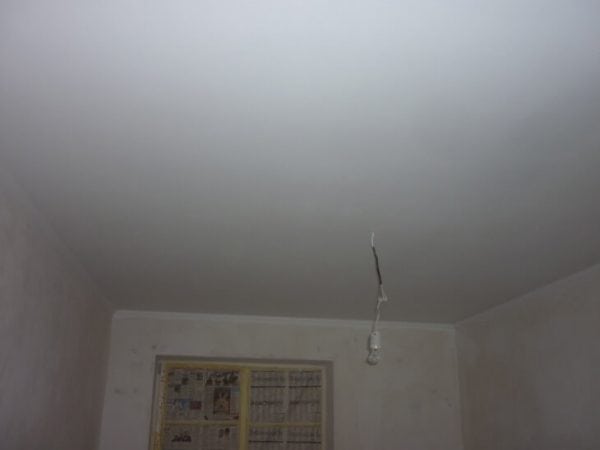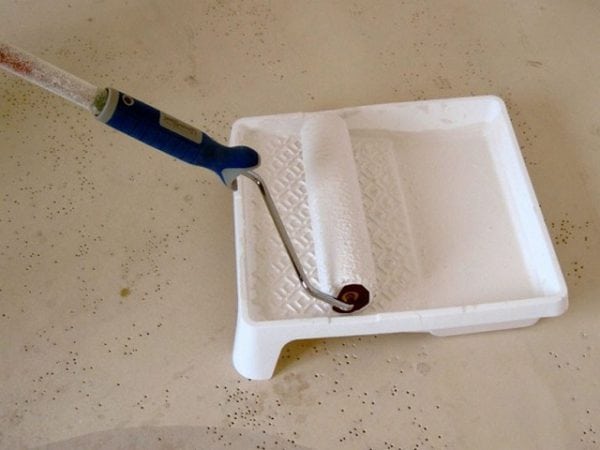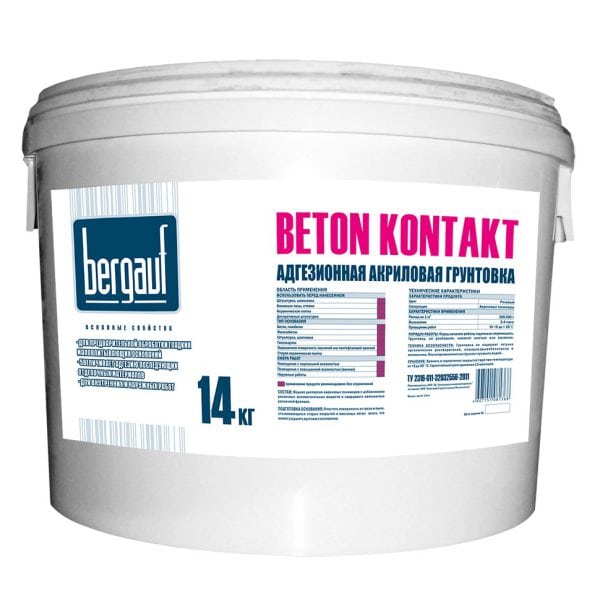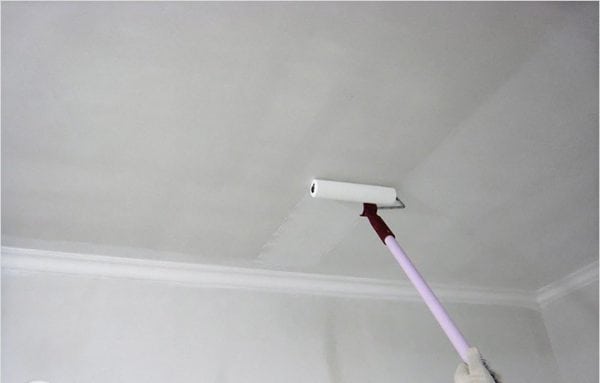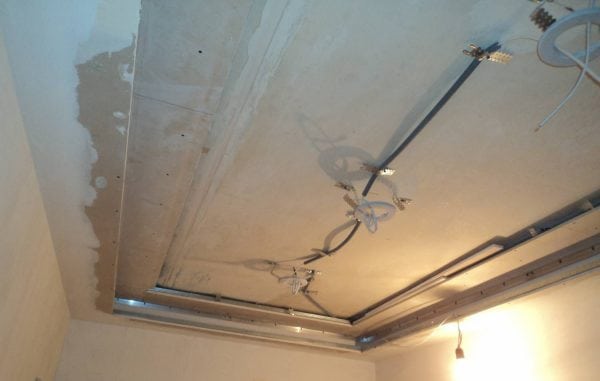A modern approach to the repair process involves the use of a number of materials. This also includes the primer for the ceiling. There is a constant debate around this milky liquid: some craftsmen do not see the expediency of its use, while others, on the contrary, consider the primer to be an obligatory component of the repair. Knowledge of all the subtleties of use helps to avoid doubt.
- Destination
- What are primer mixes
- Impregnating
- Firming
- Adhesive
- Selection based on the basis
- Special cases
- Primer before puttying
- If ceilings are stretch
- Important point
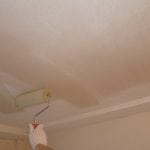
Destination
Why do we need a primer - such a question is asked not only by beginners of the construction process, but also by very experienced craftsmen. The purpose of the fluid is as follows:
- Hardening concrete surface. The liquid consistency allows the product to be easily absorbed. The water contained in it, under the influence of positive temperatures, gradually evaporates, leaving solid particles in the concrete. The latter are responsible for increasing the strength of the ceiling surface.
- Increased adhesion. The primer creates a film on the ceiling, which improves the adhesion of the slab and the finishing material.
Some varieties of the drug have bactericidal properties. After their application, the ceiling surface becomes resistant to the appearance of mold, the development of fungal spores. This quality is invaluable for rooms where children, as well as people with diseases of the respiratory system, are for a long time.
The question often arises as to whether the ceiling should be primed before painting. The main purpose of the product is to prevent moisture from being absorbed by the ceiling surface. A missed liquid treatment step during staining will manifest itself in requiring more layers to uniformly cover the entire surface. Even having putty, it is impossible to exclude the possibility that the paint will begin to crumble after a while.
to contents ↑What are primer mixes
Materials for processing ceiling tiles have a different composition depending on the type of base surface. It is also important to consider the type of room. For example, an acrylic, alkyd primer, as well as a tool with a mineral base, is the best choice for rooms in a house, apartment, office.
Acrylic primer can have a different composition, which allows you to divide it into several types.
Impregnating
Such a tool is needed when working with a loose base. The loose structure of the plaster mixes and putty allows the latex-containing product to penetrate to a depth of 10 cm. As a result, it is a monolithic base that will last long enough.
Firming
Especially does not penetrate the base. Its purpose is to connect those parts of the base that are weakly held. Such a composition is used, for example, if the ceiling is covered with plaster with a small fraction. Also, such a primer is needed if you need to strengthen minor cracks.Both of these types of primers are indicated for working with surfaces that have previously been whitewashed.
Adhesive
Due to the presence of acrylic in the composition, it creates a film on the basis. In the future, this can significantly save on finishing materials for subsequent work. This type of primer is easily combined with almost any paint. Even putty is much easier to apply.
How long does any kind of acrylic primer dry? On average, from 6 to 12 hours. The exact time depends on what the foundation was.
to contents ↑Selection based on the basis
- The primer for the ceiling for painting, having a water base, is suitable for water-based coatings and paints. This tool is recommended for use when you need to prepare a drywall, wooden, concrete or cement base for wallpapering. Such a primer dries quickly enough. At this time, even slight temperature differences should be avoided.
- For substrates made of fiberglass, an alkyd-based primer is recommended. The finish layer is very durable.
- Ceilings made of brick, concrete, expanded clay concrete and gas-silicate blocks, as well as finished with plaster, it is better to cover with a mineral-based primer.
to contents ↑
Special cases
Many owners of old homes are wondering how to prime the ceiling (and whether it is worth doing it) if it is whitewashed or it is planned to put putty on it.
Most often, the question of the need for priming a base that was previously whitewashed arises when the landlord decides to paint the ceiling. Before starting work, you should determine what served as the basis for the applied composition - chalk or lime:
- Whitewashing with lime, if it is not covered with cracks and does not fall off, just wipe it with a damp cloth. After the surface is completely dry, you can safely proceed to priming and staining (even with water-based paint).
- For chalk coated surfaces, you must carefully evaluate the surface condition and determine how many layers have been applied. In the absence of cracking and a thick layer, the ceiling is coated with a special whitewash primer.
How to apply a primer on a previously whitened ceiling? The technology includes preliminary cleaning of the surface from dust and other contaminants. After this, it is recommended to apply the first test layer. Then you should wait from two hours to a day - the primer composition dries so much, depending on its basis. Drafts should not be allowed - the risk of delamination of the base coat increases.
After the first layer is completely dry, and on the surface there is no sign of delamination or swelling, the second is applied. How many layers should there be? Experts say no less than three. And before applying a new one, you should wait for the recommended time until the previous one dries. If even minor violations of the strength of the base were detected, it is recommended to return to the stage earlier and completely remove the old coating.
to contents ↑Primer before puttying
How to prime the ceiling if putty is applied to it? And is there a need for this? The priming process in this case allows us to solve two problems:
- Disinfection. After the product is applied to the ceiling plate, its surface receives reliable antifungal protection.
- Adhesion enhancement. Putty is a rather heavy material. Therefore, in the absence of a primer coating, it may begin to peel off over time. Technology involves layering. That is, after the putty layer is applied and sanded, it is coated with a primer.
The product must not be applied while the base is dry.The type of primer used and the material of the ceiling plate determine how long it will take.
to contents ↑If ceilings are stretch
Consider whether and how to prime the ceiling on which the structure with the PVC film will be installed. Stretch ceiling - the best solution for apartments in new buildings. Over time, the house shrinks, after which the surface of the plates becomes cracked. To minimize repair costs, homeowners also resort to using a tensile structure.
PVC film reliably hides all the flaws. After its installation, you can forget about the repair for a long time. However, this does not mean that the surface under the tensile structure should not be treated. The primer is the minimum that can be limited.
As you know, a stretch ceiling often protects an apartment from moisture coming from the top floor. It is easy to remove. But while the untreated surface of the plate dries, microbes multiply in it, fungi can develop.
to contents ↑The primer provides protective properties. That is why the ceiling under the tensile structure must be processed.
Important point
When choosing a primer, one should take into account not only the period of time how much it dries. First of all, it is necessary to determine the amount of funds that will be required for surface treatment.
To find out how much primer is needed, determine how many square meters to be treated. The resulting figure is multiplied by the flow rate according to the instructions. You should also consider such nuances:
- type of primer;
- purpose of funds;
- base material.
Given these points, it is easy to determine how much money is needed to evenly and fully cover the ceiling.
It is important to remember that another important point affects the calculations - the layer thickness. This indicator depends on how porous the material of the ceiling base is. The higher the porosity, the more layers may be required. In order to avoid mistakes, it is better to involve specialists in the calculations.

